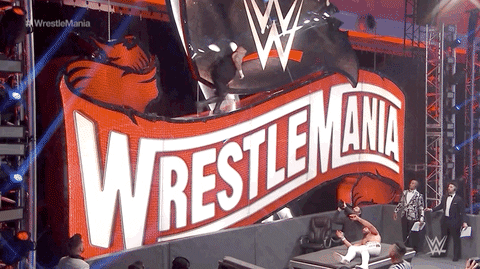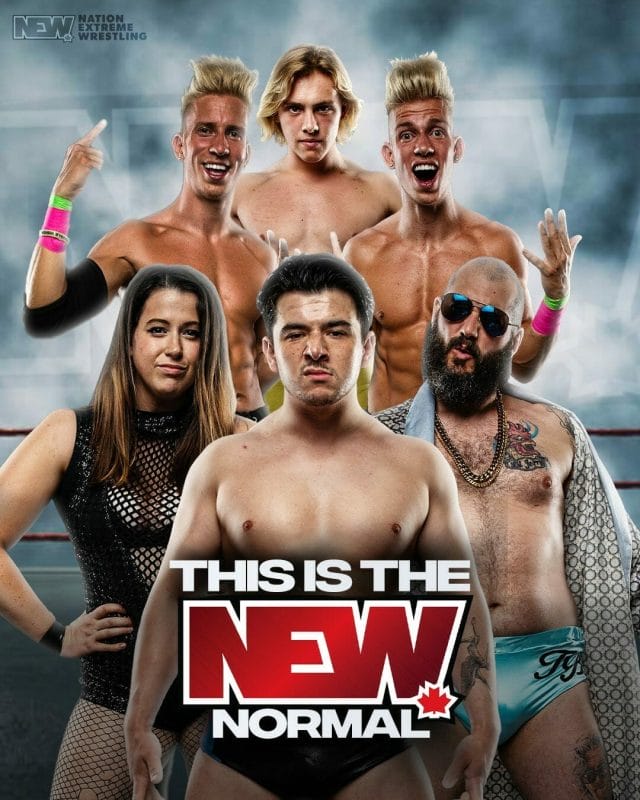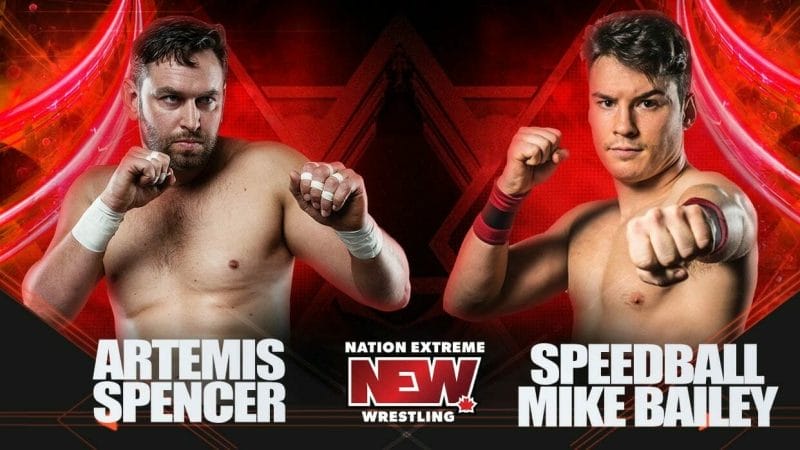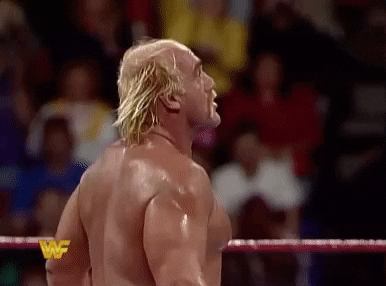Don’t judge, but I love professional wrestling. Part sport, part action movie, part soap opera, pro wrestling when it’s done well is far more than the trailer park-inspired cheap laughs fodder folks assume only takes place in the real world between truck and tractor pull events and demolition derbies.
I usually put it this way: If you like action movies, you tend not to think about how every scene was done multiple times, with fake props and blasting caps and trapeze wires and special effects and greenscreens. You just see a dude throw a punch and a woman run up a wall and think, ‘cool..’
Now, imagine if that action movie was done in real time, where every move had to land without error, without safety harnesses, and is often written not in advance, but as it happens.
Imagine if the director said, “You two guys fight and in the end the good guy wins” and everything else was just figured out as they went.
Imagine if there was nobody yelling “Cut!” and a few thousand people were ten feet away screaming at high volume as it all happened and you had eight minutes to tell a story and that sometimes the actors took a punch to the face for real and had to just eat it and keep going.

You can pay all the respect you want to the NFL, but those guys wear helmets. You can pay respect to stuntmen, but they make union pay, get multiple takes, and a boatload of special effects and re-takes to sell their craft while professional wrestlers fly through their from 20 feet up, hit the concrete floor, bleed, and get up to pull their next move while being booed by a crowd. They collide, get slammed, land on their heads, go through tables and ladders and out into the audience and, remarkably, they make changes as they go based on constant audience feedback. They constantly train to perfect new moves nobody has seen before that take their level of personal risk to an all time high.
I’ll say it right here, professional wrestling, when done right, at its highest level, is better than any pro sport. It’s a multi billion dollar industry in the US alone that can create superstars that cross over into other sports, or draw talent from other sports, and bleed into Hollywood movies and more. The competitors are real life superheroes and villains and the best of them transcend far beyond the squared circle.
Just go down the list of wrestlers who’ve gone Hollywood. The Rock, John Cena, Dave Batista – and Hulk Hogan and Andre the Giant before them. Rowdy Roddy Piper’s turn in the cult classic They Live shows you don’t just need to be a big guy to get over in wrestling or Hollywood, but you need personality, intensity, and screen chops. Beyond doing the moves, you have to actually be able to act.
And if you can act while launching yourself off the top of a cage, in front of 50,000 screaming fans, you can damn sure handle running about in front of a green screen pretending to be chased by dinosaurs.
All of that said, World Wrestling Entertainment (WWE.NYSE) should be the end of a production line of independent wrestlers and the beginning of a production line that spins the best of them off into bigger platforms and countless profits. It should be a money making machine that transcends body slams and rolls into a Marvel Universe-like multi-platform content paradise that allows fans to never leave and to dump all their money while they stay.
Instead, it’s dying.
WWE, WE’VE GOT A PROBLEMhttps://t.co/ytCwTtxILs
— Mick Foley (@RealMickFoley) September 7, 2021
Under attack from the upstart AEW, which is drawing TV ratings and former WWE stars and critical acclaim with a clearly better product, the WWE recently decided to ‘clean up the books’ by letting go of a bunch of its big name talent and made the bizarre statement that it was getting out of the ‘hiring independent wrestlers’ game, and into the ‘find guys who are 6’3″ and built like a truck, and teach them how to be wrestlers’ business. No longer will they look for indie stars with an abundance of personality and talent and intensity and creativity and an existing following. Now they’re going for a ‘body type’ and will figure out the rest through training.
The WWE has lost it. They think the Marvel Universe is Thor and Captain America. They don’t realize that for every Thor, you need a Deadpool, and that if Thor spends more time talking than actually swinging a hammer, nobody will give a shit..
The reason for this shift in how the WWE does business is multi-fold:
1. The company is creatively bankrupt. A recent storyline is that one of its stars has ‘fallen on hard times’ and needs to borrow money for child support, while walking around with mustard stains on his shirt. Cool. Can’t wait to buy that lit ‘divorced dad’ merch.
2. The company’s shows are just terrible. 22 minutes from opening credits to the first actual match? Title changes on a random Monday after five moves? 3D holographic video intros? Long scripts that bore the audience? Where’s the actual personality and, you know.. wrestling?
3. The talent being pushed is not particularly talented. Instead of paying former champions millions to come out of retirement for a handful of matches in their 50’s and 60’s, why not foster an actual deep roster? When your champion is actively booed by fans not because he’s a villain, but because nobody enjoys watching him, you’re deep in the weeds as a business.
WWE makes money, but not nearly as much as it once did. The had built a decent enough recurring revenue subscription business that at one point had 2 million subscribers, but they’ve never been able to go beyond that which made the service only so valuable as a revenue generator, or as an acquisition. NBC recently announced it would consume that entity and put it out over their 22 million-subscriber Peacock service, which gets WWE to a wider audience potentially, but also takes away all their potential upside now that they don’t own the rails.
The real problem is one of management. Vince McMahon used to be involved in every inch of the WWE business, having taken it over from his father and turned it into an ‘indie wrestling roll-up’ with piss and vinegar that took out most of his under-funded and loosely run regional competition in the space of just a few years, and made the company large enough to break into mainstream TV. Over the years, his leadership kept the ship sailing but haven’t done much to grow it beyond its base. More recently, McMahon shoveled a load of money into his poorly timed XFL football rebirth, right as Covid hit, which took his time, cash, and attention away from the core business.
The WWE has survived steroid revelations, wrestler deaths, sexual abuse allegations, changes in audience taste, and some well-funded challengers over the last 30 years, including from groups like the UFC who took wrestling elements to the world of real fighting, but it has always usually topped out as a sort of NASCAR Lite passion for guys of a certain type rather than an actual mainstream competitor with pro sports.
Don’t get me wrong, wrestling draws a big audience anywhere it happens, but if you’re wearing a John Cena t-shirt to a job interview, it better be for the night shift at the Gas’n’Sip.
It doesn’t have to be that way.
Pro wrestling on the independent circuit is different. The audience is a firm 25-40, it still leans male but not nearly as male as in years gone by, the audience wants to be as close to the action as possible, not stuck in the nosebleeds, there’s an extraordinarily high level of diversity in the crowd and the talent, and the connection between the folks in the ring and out is strong because everyone knows the wrestlers are doing it almost entirely for the love and the cheers.
On the indie scene, wrestlers could be turning up to a 75 person show in a scout hall or a midnight show in a bar, or an all ages show at a fairground or even a backyard party. If there’s gas money to be had and a chance to get injured for the enjoyment of others, you’ll find no shortage of takers.
There are no ‘Doink The Clown’s on the indie scene. Nobody in a suit is telling a promising indie talent to put on a chicken costume and crow at the crowd. They might not make a living doing it, but the indies are where pro wrestling comes home. The passion inside the ring and the passion outside it meet in a crescendo of love in the middle. I’ve been to wrestling shows where nobody sits down at their assigned seats and everyone is double fisting beers and the noise is deafening and the wrestlers are seemingly telling the crowd, ‘you thought that was fucking insane? Watch this.’
The WWE can’t tap into that because, at it’s core, the WWE wants to be bought by Disney. It wants to be a place where pretty people learn how to take a clothesline and say their pre-assigned lines. And because it wants to be bought out, the WWE has tamed itself into unimportance.
When I was growing up, the whole ‘rock n’ wrestling’ thing was just picking up, and Hulk Hogan and Mr T were tag-teaming as Cyndi Lauper bounced around behind them and ads for The Goonies, starring half the roster, played behind that. The in-ring product was pretty ordinary back then – nobody was doing the sort of top flight luchador stuff that’s expected as standard nowadays, rather you’d watch The Junkyard Dog stumble arthritically to the ring and bop his knees a bit as his theme song ‘Grab Them Cakes’ played. Every match, he’d take a few punches and kicks, then clothesline his unheralded opponent, then body slam him, and the match would be over without him needing to take more than a half dozens steps. Cue theme song. Thinking back, it was terrible.
But that was miles better than the product the WWE puts out today.
Imagine this: The Expendables 6, featuring The Rock, Batista, and Cena. You’d go see that. I’d go see that. So how has the WWE created these stars and somehow not managed to capitalize on their leveling up to movies?
They’ve tried in the past. This is what came of it.
WWE Studios should be a means of taking WWE storylines to the next level. Instead it quickly drove into C-grade action vehicles for their stars of the moment, then reality TV, random movies they might make a buck from, and now any old shit they might be able to squeeze a wrestler into. Or not.
- WWE announced the first three film projects in January 2005; The Condemned, starring Steve Austin, The Marine, starring John Cena, and Goodnight, later retitled as See No Evil, starring Kane.
- WWE Studios and Warner Bros. co-produced a Scooby-Doo animated feature that found Scooby and the gang solving a mystery at WrestleMania, which also starred an ensemble of WWE Superstars.
- In February 2014, WWE announced the sequel to the 1996 film Jingle All the Way, to star Larry the Cable Guy and WWE wrestler Santino Marella.
- In February 2019, it was reported that WWE Studios and Netflix came to an agreement that would see WWE Studios produce new family-friendly movies for Netflix’s platform.
- In July 2019, it was announced that WWE Studios will be producing its first television show, Fight Like A Girl, for Quibi.
- In March 2021, the Game Show Network revealed at their upfront; they signed a deal with WWE Studios to develop shows hosted by WWE talent.
If you were making a movie about today’s WWE, you might call it Death of a Salesman, because this group is befuddled at what it could be, what it could have been, what the world has become, and their place within it.
The subscription model has been cast aside. They still make some money from live shows, but there’s no room for growth there. They still make money from TV shows, but ratings are collapsing. Merchandise sales are still a thing, but there’s only so many wrestling t-shirts a guy can wear and still be dateable.
So hey, buy WWE stock? Why would you?
The re-rise of wrestling, and the fall of World Wrestling Entertainment (WWE.NYSE)
This company is the Blockbuster of sports entertainment. It’s dead, it just doesn’t know it yet.
Sure, people still go to their shows, but people also go to watch The Price is Right because it’s fun to see a TV show being filmed. They wear merchandise that touts champion Roman Reigns, but they boo Reigns when he shows up. Recently, John Cena has returned from making multiple successful movies to lend the WWE some star power, but even he publicly makes fun of the fact that the Reigns routine ‘just doesn’t work, no matter how hard they sell it.’
Hell, he was speaking that truth four years ago.
Recently, WWE paid millions to bring Brock Lesnar out of retirement, and forced Goldberg, who was big when I was little, to come back as a main event player. Nobody wants this. Nobody wants any of it.
So at Equity.Guru we thought about what we might do in the knowledge that WWE is a dead company walking.
Should we short the stock? Should we find other wrestling groups to invest in? Where’s the opportunity?
And then someone in the back of the office said, “What if we just.. put on a show?”
Like, what would happen if we decided to do it right? What would happen if we found talented local professional wrestlers and broke them out of the old model, where they’d put their lives in their hands for next to no money, in whatever venue they could find, sometimes driving across borders to put their lives on the line for gas money?
What if we didn’t follow the old model, where you start at the bottom in a Legion Hall and work your way up, but rather started in the middle, with a well financed promotion that understood you can reach millions online even if they can’t get into your shows, where you try to make every event TV-worthy, where you let the talent be creative and the experts be expert? What if you kept live audiences small and enthused, but made the online audience large and stoked? What if you supported a talent pipeline, giving young rookies regular work and veterans respect? What if you cleaned the room out of those who bring baggage and drama, and ensured a work environment that’s positive, diverse, safe, friendly, and paid just a little more so folks could consider quitting their day job?
What if you DIDN’T lock talent into exclusivity deals and instead saw their career elevation as something to celebrate? What if you kept the jibber jabber to a minimum and the action at full bore, and didn’t rely on chair shots and thumb tacks and blood but rather storylines, relatable characters, and audience connection? What if you encouraged fan favourites to compete against other fan favourites, and let the audience choose who they love rather than telling them who they’re supposed to love?
What if?

Well, we get an answer on Saturday September 11 at The Gaming Stadium (TGS.V) in Richmond, BC, where we’re putting on two shows that, in my opinion, have more talent loaded into them than anything I’ve seen on TV in decades.
Nation Extreme Wrestling (NEW) opened for ticket sales last week on a 7pm show and sold out in a single day, with no media promotion other than a podcast and some social media posts, on the back of a lineup that is wall to wall bonkers.

We’ve lined up a who’s who of local wrestling names that we believe will deliver something this province hasn’t seen in decades.
Once we sold out our first show, we added a bonus main event featuring longtime west coast king Artemis Spencer vs Canada’s hottest indie talent, Speedball Bailey. To be clear, we didn’t need to – we’d already made our money.
But we HAD to because it’ll be AWESOME.
We then added a family-friendly matinee show (we’re calling it the NEWner) at 2pm on the same day, featuring another northwest legend in Nicole Matthews fighting US star Veda Scott, and TikTok icons The Voros Twins taking on local tag team stars in the making, Re:Loaded.
We’re actually doing this.
It’s really a thing. We’re putting on a show. The same year we bought an interest in an English football club, Equity.Guru now has a pro wrestling promotion.
Sometimes you invest in other people. Sometimes you invest in what the people want.
— Chris Parry
FULL DISCLOSURE: We own Nation Extreme Wrestling and no, we’re not taking investors… yet.

